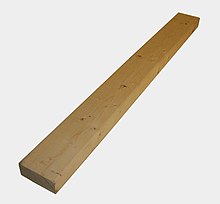Board foot
| board foot | |
|---|---|
| Unit of | Volume |
| Symbol | FBM |
| Conversions | |
| 1 FBM in ... | ... is equal to ... |
| SI base units | ≈0.002359737 m3 |
| US Customary | 1⁄12 ft3 |
The board foot or board-foot is a unit of measurement for the volume of lumber in the United States and Canada. It equals the volume of a board that is one foot (30.5 cm) in length, one foot (30.5 cm) in width, and one inch (2.54 cm) in thickness, or exactly 2.359737216 liters. Board foot can be abbreviated as FBM (for "foot, board measure"), BDFT, or BF. A thousand board feet can be abbreviated as MFBM, MBFT, or MBF. Similarly, a million board feet can be abbreviated as MMFBM, MMBFT, or MMBF.
Until the 1970s, in Australia and New Zealand, the terms super foot and superficial foot were used with the same meaning.[1][2][3]
Description
[edit]One board foot equals:
- 1 ft × 1 ft × 1 in
- 12 in × 12 in × 1 in
- 12 ft × 1 in × 1 in
- 144 cu in
- 1⁄12 cu ft
- ≈ 2,360 cubic centimeters
- ≈ 2.360 liters
- ≈ 0.002360 cubic meters or steres
- 1⁄1980 Petrograd Standard of board
Usage
[edit]
The board foot is used to measure rough lumber (before drying and planing with no adjustments) or planed/surfaced lumber. An example of planed lumber is softwood "two by four" lumber sold by large lumber retailers, nominally 2 by 4 inches (50 mm × 100 mm). The 2 × 4 is actually only 1+1⁄2 in × 3+1⁄2 in (38 mm × 89 mm), but the dimensions for the lumber when purchased wholesale could still be represented as full 2 × 4 lumber, although the "standard" can vary between vendors. This means that nominal lumber includes air space around the physical board when calculating board feet in some situations, while the true[clarification needed] measurement of "board feet" should[clarification needed] be limited to the actual dimensions of the board.
For planed lumber, board feet refer to the nominal thickness and width of lumber, calculated in principle on its size before drying and planing. Here, the actual length is used.
Note: see dimensional lumber for a full discussion of the relationship of actual and nominal dimensions. Briefly, for softwoods, to convert nominal to actual, subtract 1⁄4 inch (6 mm) for dimensions under 2 inches; subtract 1⁄2 inch (13 mm) for dimensions over 2 inches and under 8 inches; and subtract 3⁄4 inch (19 mm) for larger measurements. The system is more complicated for hardwoods.
See also
[edit]References
[edit]- ^ Rowlett, Russ. "How Many? A Dictionary of Units of Measurement". Retrieved 2007-01-30.
- ^ Burger, Les. "Cutting Timber on Springbrook in 1935". Archived from the original on September 17, 2007. Retrieved 2007-11-06. Archived 2007-09-17 at the Wayback Machine
- ^ Holgate, Alan. "The Bendigo Monier Arch Bridges". Archived from the original on 2007-07-02. Retrieved 2007-11-06. Archived 2007-07-02 at the Wayback Machine
